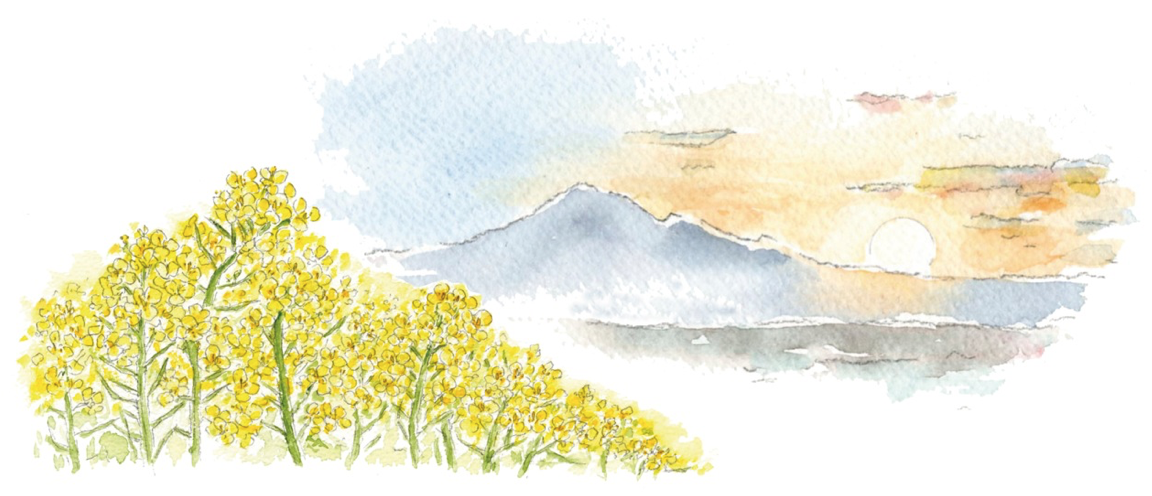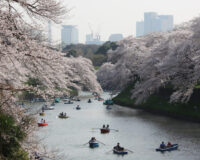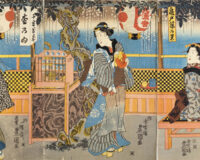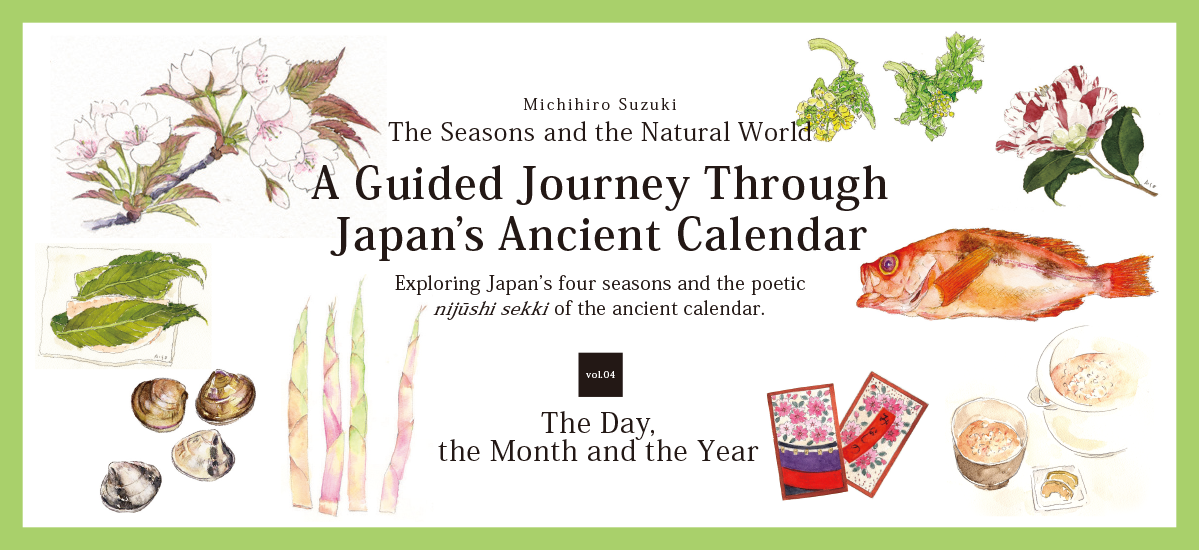
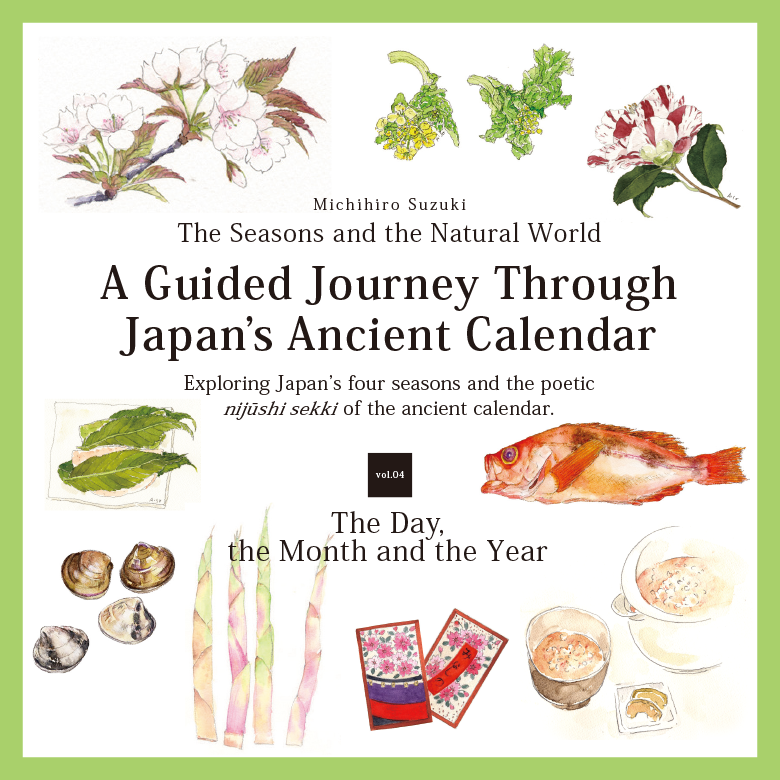
We explore the four seasons in Japan and the poetic nijūshi sekki (twenty-four seasonal divisions) of Japan’s ancient calendar, expressed in the waxing and waning of the moon and the movement of the sun across our skies.
In this article we look at the origins of the three units of measurement in our calendar – days, months and years.
Text : 鈴木充広 Michihiro Suzuki / Illustrations : Aso Yuriko / English Version : Judy Evans
Keyword : History / Japan’s Ancient Calendar / Koyomi / Japan's Ancient Calendar Series
The Day, the Month, the Year and the Calendar
Humans have created calendars since time immemorial, each one developed to a greater or lesser degree in relation to the units of time derived from the movement of the sun and the moon – the days, months and years. Since we can’t talk about calendars without mentioning these words, I thought I’d share my thoughts around how these units of time came into being. I could go on at length, but here’s my nutshell version.
The Day「日」
Let’s first take a look at the day, perhaps the first unit of measurement that humans came up with to express the passage of time.。
Essentially, this unit measures the length of one cycle of daylight and dark. The repetition of day and night is created by the daily movement of the sun due to the earth’s rotation, but, unaware that the earth was spinning, our predecessors would have accepted the unit “day” as being the basic cycle of waking up in the morning, going to bed at night, and waking up again in the morning.
The word koyomi, the old Japanese word for calendar, most likely originated as ka-yomi. Ka is one of the ways of pronouncing the kanji 日, which means day or sun, while yomi means to count or measure time. It is therefore thought that the koyomi(calendar) started out as a tally of the passing days.
The Year「年」
Having just dealt with the day, you might have expected us now to be considering the month, but let’s jump ahead of ourselves and consider the year instead.
One year is the length of the cycle of seasonal changes that occur as the earth orbits the sun. Each passing year leaves its mark on most plants and animals, including humans. Hunting and farming activities must both take the yearly cycles into account. To understand how our ancestors perceived the year, let’s take a look at how the word for year is written in Japanese.
The kanji for year 年 is thought to be composed of two separate characters: the radical for grain 禾, combined with either sen 千, the kanji for thousand, or possibly nin 人, the kanji for person, either having the same sound in the old ongana phonetic writing system.
Nogi 禾 refers to grains such as rice and barley that have bristles or awns at the tips of the ears. Combining nogi 禾 with sen 千(thousand) signifies a large amount of grain or, in other words, a harvest.
So, the character nen 年, which represents the harvest of grain, was used by our ancestors to express the interval of time between one harvest and the next. In other words, one year. The harvest was the fruit of one year’s labour, so it makes sense that the character for “year” would have been formulated in this way. Interestingly, the derivation of this character gives us an insight into the lives and concerns of our forebears.
The Month「月」
Now we come back to tsuki 月 (month), the unit of time that we skipped earlier.
As we’ve seen, the day and the year are closely linked the basic cycles of almost all living things, including humans. These two units of time, both day and night, and the seasonal changes, are, of course, solar – based on the movement of the sun. In contrast, months bear no relationship to the sun. Instead, months are lunar, based on the moon.
I tried giving some thought to how the moon affects our lives in any way comparable to the way the sun brings about night and day and the seasonal changes, but I couldn’t come up with anything. So, what purpose does the month have as a unit of time? Personally, I believe months came about as a handy way of dividing the year into more manageable lengths of time.
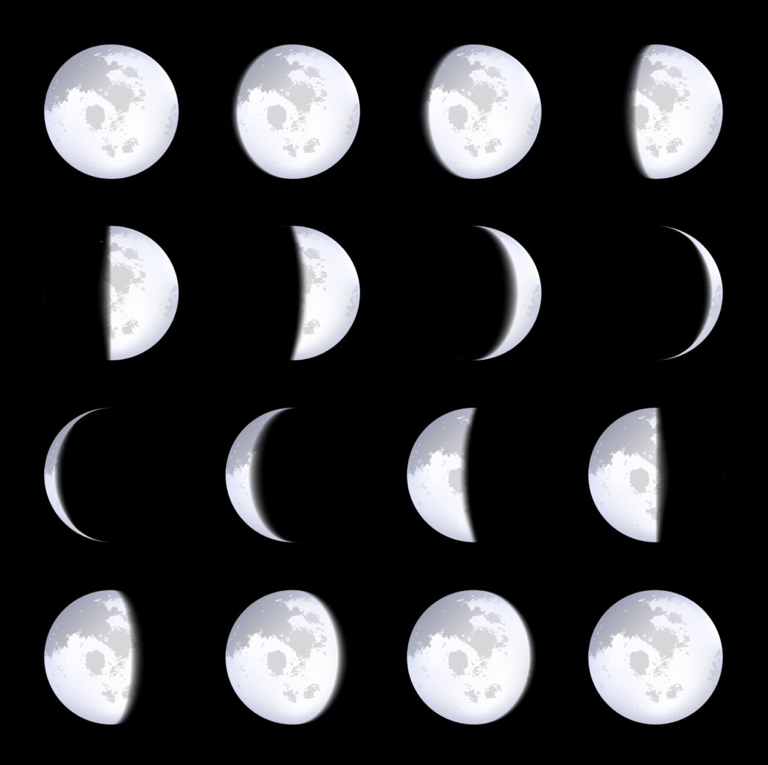
One of the first characteristics that comes to mind when we think about the moon is its more or less fixed cycle of waxing and waning every 29.53 days. While this lunar cycle has no particular influence on our daily lives, it is certainly a phenomenon that everybody notices. At archaeological sites in all parts of the world, items such as animal bones bearing twenty-nine to thirty carved marks thought to be related to the lunar cycle have been unearthed. These intriguing objects, the earliest being over 10,000 years old, are quite possibly primitive calendars.
We’ve established that koyomi, the Japanese word for calendar, means counting the days. Certainly, when you count from day one to day three hundred and sixty-five, you do end up with one whole year, but that’s an awful lot of days to count without losing track. Wouldn’t it be more convenient to subdivide the year into shorter sections?
This is where the lunar cycle comes in handy. The phases of the moon would have provided a useful tool for organising the days of the year into smaller groupings, with the added benefit of being plain for all to see, up there in the sky as it is.
As an aside, the name of the Japanese god of the moon from the ancient chronicles is Tsukiyomi-no-Mikoto 月読命 (or Tsukuyomi-no-Mikoto). Tsuki or tsuku mean moon, while the yomi part is the same as the yomi in koyomi (calendar), and refers to counting time. The way tsuki (moon) and yomi (measuring time) are put together to form the name of the god of the moon, shows a pretty strong link between the moon and the calendar, in my humble opinion.
The Moon in the East, the Sun in the West
Let’s head off on a poetic tangent now. In 1774, the famous Edo Period poet, Yosa Buson, penned the haiku “nanohana ya / tsuki wa higashi ni / hi wa nishi ni”, which translates as “Rape blossoms / the moon in the east / the sun in the west”.
This poem was composed on the twenty-third day of the third month of the old calendar, which, according to the modern calendar, would have been early May.

Imagine, if you would, a field of yellow rape blossoms just as the sun is about to set. Looking toward the east, you see a big moon rising above the horizon. Meanwhile, in the western sky, the setting sun is about to disappear from view. A beautiful spring scene with luminous sky and brilliant colours. The sun in the west, the moon in the east. Both of the heavenly bodies that gave us the days, months and years of the calendar happily sharing the same sky, melting into the landscape.
Earlier, I mentioned that the moon has little influence over our daily lives, but please don’t misinterpret my intent. I didn’t mean to imply in any way that the moon is insignificant. I would never be so rude! After all, the brilliance of the full moon touches our hearts far more than the everyday brilliance of the sun. The full moon occurs precisely when the sun and the moon are aligned on opposite sides of the earth. So, as in Buson’s haiku, it ought to be possible once a month to see the moon rising on the eastern horizon while the sun sets at the same time on the western horizon. But only if we pay attention to such things. With our modern lifestyles, we tend to forget to look up and notice what’s happening in the sky. Why not stop what we’re doing from time to time, and take a moment to find the moon in the sky?
Finally, as a reward for having stuck with me so far, here’s a riddle for you. Why is it unlikely that Yosa Buson penned this haikuwhile he was looking at such a scene? (The clue is in the date on which the haiku was written).
